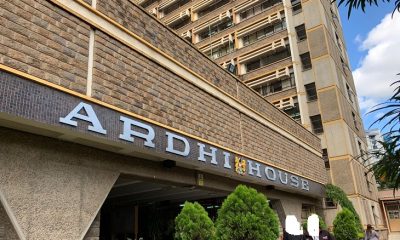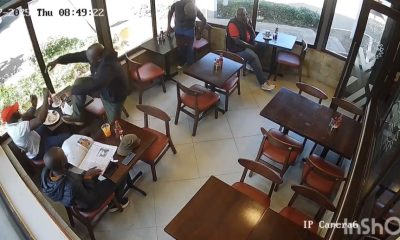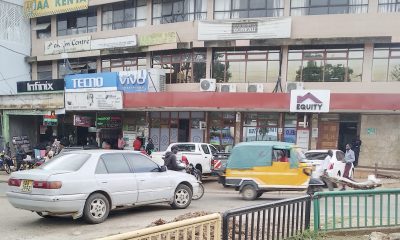US Unrest
Camera Phones Brings To The World The Real Police Brutality And Racial Violence On The Blacks In America

On May 25, 2020, unarmed, 46-year old Minneapolis resident George Floyd died after being restrained by officer Derek Chauvin whose knee was lodged into his neck as he lay handcuffed, face down in the street for 8 minutes and 46 seconds. Considered a “gentle giant” by family members, friends and co-workers because of his height, George Floyd was an African American man who was arrested by Chauvin, a white police officer, for allegedly using a counterfeit $20 bill to buy cigarettes at a local grocery store. Before his death at a local hospital about an hour later, bystanders watched as Chauvin maintained pressure on George Floyd’s neck as three other officers did absolutely nothing to stop what clearly was an intrusive use of force. All of these actions were captured on the camera phones of nearby onlookers attempting to help yet another Black man immobilized by the police.
In the last eleven years, mobile technology has become a communications staple for vulnerable populations, particularly smartphones. Twenty-five percent of African Americans and 23 percent of Latinos are smartphone-dependent, carrying the medium as their primary mode of communication. In recent years, individuals, who have witnessed physical encounters between citizens and the police, recorded them, sometimes revealing the depth of the institutional terror waged on Black people by law enforcement.
With the long history in America of violence against Black people, the ubiquity of video recordings has recast the narrative surrounding police violence and heightened public concerns about law enforcement. In today’s world, virtually anyone can be a videographer and filmmaker. The combination of smart phones, video recording apps, and social media platforms have generated a revolution in public empowerment. Rather than having to take the word of African Americans over the police, people can see the violence for themselves and demand justice.
These factors should explain why recorded observations of police brutality against African Americans trigger protests, even during a global pandemic. Technology is becoming part of the story regarding how marginalized populations in the U.S. and across the world are recording injustice and thereby, gaining personal empowerment. Leveraging the internet, civilian-generated video content can move public opinion toward more critical views of law enforcement and mass incarceration.
The troubling pattern
In the Floyd case, videos taken by onlookers’ camera phones showed his final moments as he screamed out three words, “I can’t breathe!” followed by cry for help to his deceased mother. The recordings reminded people of the same phrase previously heard from another unarmed Black male named Eric Garner, who was placed in a tight chokehold by officer Daniel Pantaleo in Staten Island, New York. After being arrested on July 17, 2014 for allegedly selling single cigarettes from a carton without a tax stamp, Garner’s physical exchange with law enforcement ended with him on the ground, turned on his side to stabilize his breathing until his death an hour later at a local hospital. After seeing Eric Garner overpowered by police, more than 50 national demonstrations rejecting Pantaleo’s actions erupted. One month later these would be followed by the protests and riots in Ferguson, Missouri, after Officer Darren Wilson failed to be charged for killing unarmed 18-year old Michael Brown after he was accused of stealing cheap cigars and shoving a convenience store clerk. Three years after Brown’s death, surveillance footage revealed a non-violent African American male in a convenience store, countering Officer Wilson’s story.
George Floyd’s fate is shockingly similar to those of Eric Garner, Michael Brown and the countless others whose lives were shortened by police brutality. The recordings of his encounter sparked protests among thousands of Minnesotans and out-of-state protestors, demanding that all four officers be immediately fired and charged. Five days later, Chauvin would be charged with third-degree murder and within days of transferring his case to the state’s attorney general, Keith Ellison, the charges were upgraded. Ten days into the national protests, the remaining three officers were charged with aiding and abetting in the crime that caused Mr. Floyd’s death.
Why are police shootings more visible?
Not since the painful images of the open casket for Black teenager Emmett Till in 1955 has all of America seen what racial violence looks like in the U.S. Emmett’s mother, Mamie Till Bradley, decided to televise his funeral with an open casket, allowing mourners in person and on television to see his mangled stature, swollen face, and body after being brutally attacked in the South.
Despite Trayvon Martin’s fatal encounter with White vigilante George Zimmerman not being videotaped, the 17-year old’s death in 2012 was probably the next most powerful image of an unarmed, Black man in a “hoodie,” that invoked suspicion of this young student who was walking in his mother’s neighborhood.
But before Martin, the murder of 22-year old, Oakland native, Oscar Grant, was the first police brutality incident to be recorded and shared via an early generation smartphone. Grant, whose story was later told in the 2013 movie Fruitvale Station, was fatally shot after being handcuffed and restrained by two Bay Area Rapid Transit Officers working for Oakland’s public transit system. Bystanders used their camera phones to capture the moments when unarmed Grant stood up only to be pushed back to the ground and shot by one of the police officers within seconds. But this video did not reach the scale of online audience of others, mainly because social media companies like Twitter and Facebook, as well as other online platforms, were not as quite mature. Compared to its 2.6 billion subscribers in the first quarter of 2020, Facebook only reported 150 million users at that time, which contained the images of activism around Oscar Grant’s death to the Oakland area, where several days of protesting occurred.
1 in 1,000 African American men have a higher chance of being killed by the police over their lifetime, according to 2019 research. The deaths of Black women follow, despite the lack of national visibility on their cases. The 2015 police body cam footage of Sandra Bland showed a violent slamming of her body to the ground after being stopped during a routine traffic stop in Waller, Texas. Three days later, she would be found dead in her jail cell, which the chief medical examiner ruled a suicide. The recent police shooting of EMT Breonna Taylor in Louisville, Kentucky, has gained greater profile during the protests, especially as its been shared that she was shot at least 8 times during a police search warrant executed at the wrong home. To raise the profile of Black women and girls shot by police in the national debate, legal advocate, Kimberlee Crenshaw, launched an online campaign, #SayHerName to tell their stories.
Even when there’s video, indictments of police are not easy
One of the few cases where a video recording led to an indictment of an officer was the death of Walter Scott in North Charleston, South Carolina. Scott, an unarmed Black man was shot in his back as he ran from a routine traffic stop in 2015. After his death, the arresting Officer Michael Slager tried to lie about what happened, but an onlooker, Feiden Santana, recorded the entire incident on his cell phone. The recording and Santana’s testimony were presented in court, resulting in a 20-year sentence in jail for this rogue cop.
But incriminating footage from camera phones may not always result in charges being filed against a given police officer(s). Even with a video, it took five years in the Eric Garner case to fire Pantaleo, due to a lengthy federal investigation and a strong New York City police union who decried any punitive actions against him. In 2019, Attorney General William Barr ordered the case to be closed. In Baltimore, the very public arrest of African American Freddie Gray in 2015, followed by the immediate indictments of all six police officers by State’s Attorney Marilyn Mosby, still resulted in no convictions.
Immediately after George Floyd’s death, President Donald J. Trump asked the Department of Justice and FBI to expedite the investigation into the details. But that all shifted within one week when the White House leaned into the protests and started focusing on far-left groups, progressive anarchists, and bona fide criminals, all of whom they suggested were infiltrating legitimate protests. Attorney General Barr would soon announce an investigation into far-left groups, like Antifa, despite the presence of known white supremacist disrupters driving some of the looting and violence in various cities.
And now, President Trump’s new focus on “law and order,” rather than the restoration of democracy and racial healing, is increasing the proliferation of surveillance by the police and military to censure these ongoing mass protests around the country. The images and videos of military de-escalation tactics that include tear gas drops and batons from protestors’ camera phones are as equally disturbing as the recording of Floyd’s murder. In various cities, some police are also deploying facial-recognition-technologies to scan the crowds of protestors and gathering location data to improve upon protest surveillance and restraint.
Technology brings pain to life
Police brutality has emerged from a history of the state’s invasive surveillance and persistent assaults on African Americans and their lifestyles. These recordings bring visibility to the historical terror and fear African Americans feel in the presence of police. Sometimes, these occurrences result in deadly consequences for Black people who cannot easily escape the realities of being racially profiled or targeted within and outside of their communities.
But unfortunately, despite how tragic and mentally traumatic the deaths of Oscar Grant, Trayvon Martin, Eric Garner, Michael Brown, Walter Scott, Sandra Bland, Breonna Taylor, George Floyd, and the countless others have been, there will be more Black men and women dying while in police custody without the structural, behavioral and policy changes to policing in America. And before these changes are even instituted, we need a national acknowledgement that racism and discrimination have normalized violence against people of color.
Kenya Insights allows guest blogging, if you want to be published on Kenya’s most authoritative and accurate blog, have an expose, news TIPS, story angles, human interest stories, drop us an email on [email protected] or via Telegram
-

 Investigations2 weeks ago
Investigations2 weeks agoMoney Bior, Lawyer Stephen Ndeda Among 18 Accused Of Running An International Fraud Ring Involved With Scamming American Investor Sh500 Million
-

 Investigations2 weeks ago
Investigations2 weeks agoNestlé Accused of Risking Babies’ Health in Africa with ‘Toxic’ Cerelac Product Sold Highest in Kenya
-

 Investigations1 week ago
Investigations1 week agoHow Land Grabbing Cartels Have Captured Ardhi House
-

 News2 weeks ago
News2 weeks ago48-Year-Old Woman Who Pushed 25-Year-Old Boyfriend To Death From 14th Floor Kilimani Apartment Arrested
-

 Investigations2 weeks ago
Investigations2 weeks agoKDC Rocked With Fresh Sh500 Million Tender Scam
-

 Grapevine2 weeks ago
Grapevine2 weeks agoMP Anthony Kibagendi Assault and Injures Kisii Man He Accuses Of Sleeping With One Of His Girlfriends
-

 Investigations3 days ago
Investigations3 days agoInside the Deadly CBD Chase That Left Two Suspects Down After Targeting Equity Bank Customer Amid Insider Leak Fears
-

 News2 days ago
News2 days agoSeven KDF Soldiers Accused Of Stealing Meth From Sh192 Million Mombasa Bust Detained For 10 More Days

















